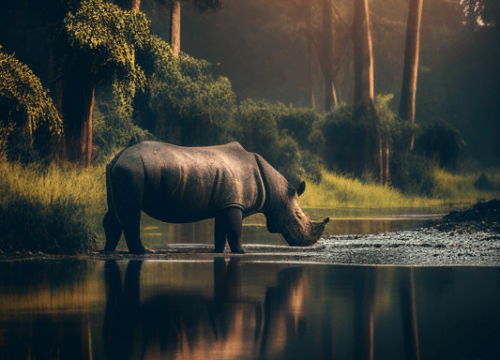Kathmandu City Tour (B)
Trip Overview
Kathmandu City Tour B: Unveiling Historical Treasures
Embark on an enriching journey through Kathmandu, Nepal’s cultural hub, and immerse yourself in the heritage of its iconic landmarks. This city tour promises a captivating exploration of historical and religious sites that showcase the rich tapestry of Nepal’s past.
Boudhanath Stupa: Ancient Splendor
Begin your Kathmandu city tour with a visit to Boudhanath Stupa, an architectural marvel dating back to the 6th century. Explore the largest Buddhist stupa in South Asia, marveling at its towering structure and intricate design. Experience the serene ambiance as you join pilgrims in circumambulating this sacred monument, soaking in the spiritual energy that permeates the air.
Pashupatinath Temple: Sacred Traditions
Continue your journey to Pashupatinath Temple, a revered Hindu pilgrimage site dedicated to Lord Shiva. Witness the sacred cremation rituals along the banks of the Bagmati River, a solemn and deeply spiritual experience. Admire the temple’s intricate architecture and ornate decorations, reflecting centuries of devotion and reverence.
Bhaktapur Durbar Square: Medieval Majesty
Immerse yourself in the medieval charm of Bhaktapur Durbar Square, known as the “City of Devotees.” Explore the 55-Window Palace, an architectural marvel adorned with exquisite wood carvings. Marvel at the towering Nyatapola Temple, a symbol of Bhaktapur’s architectural prowess. Wander through the square, admiring the intricate craftsmanship of its monuments and soaking in the vibrant atmosphere.
Dattatreya Square: Artistic Wonders
Discover another historic square in Bhaktapur, Dattatreya Square, home to the renowned Dattatreya Temple. This temple, constructed from a single tree, is a testament to the ingenuity of Nepalese craftsmanship. Explore the square’s intricate wood carvings, marveling at the skill and artistry of the local artisans. Delve into Bhaktapur’s rich artistic heritage as you peruse the handicrafts and souvenirs offered by local vendors.
Conclusion: A Journey Through Time
In conclusion, Kathmandu City Tour B offers a fascinating journey through Nepal’s history and culture. From the ancient grandeur of Boudhanath Stupa to the medieval charm of Bhaktapur Durbar Square, each site provides a glimpse into Nepal’s rich heritage and artistic legacy. Embark on this unforgettable tour and discover the timeless treasures of Kathmandu.
Trip Itinerary
After receiving you in the hotel lobby, our guide will drive you to Boudhanath, the biggest Buddhist stupa in South Asia (the vehicle's capacity will depend on the number of people in the group). Built by Shiva Dev in the sixth century, this massive stupa has been recognized as a holy site and mound of exceptional beauty ever since. This stupa will take us around an hour to explore.
We will make it from Boudhanath stupa to Pashupatinath temple, which is the most important place for Hindus, in about ten minutes. It is the shrine dedicated to Lord Shiva and his spouse, Parvati. The body is burnt on the banks of the famous Bagmati River. Because we Hindus believe that Hell is below the earth and heaven is above the sky, when a body is cremated, the smoke is believed to travel to heaven, and the remaining ash is disposed of in the Bagmati River in Varanasi, India, which connects to the Ganges, which is also believed to have a connection to heaven.
We will drive to Bhaktapur from the Pashupatinath Temple and have lunch there before exploring the city's attractions.
Bhaktapur, sometimes referred to as Bhaktapur Bhadgaon, was formerly the Nepal Valley's administrative hub. There are still examples of Middle Ages architecture and art at that location. According to legend, this city was founded in 889 AD by the late King Anand Deb of the renowned Lichhabi dynasty. Every part of the city is like a "Khat-Kon," or David's Star. Known as the "City of Devotees," Bhaktapur is primarily populated by Hindus. The metropolitan region is four square miles in size. Pottery and weaving are two of the traditional businesses in the nation.
The city's central square, which once served as the old Bhadgaon kingdom's capital, is home to several beautiful natural landmarks and temples. The 55-window palace constructed by the late King Bhupatindra Malla, which the three surviving kingdoms of Kantipur, Lalitpur, and Kirtipur greatly coveted, is the first imposing city landmark. Politics may also be a source of conflict as a result of this envy. Bhaktapur and Lalitpur in particular stood out as fierce rivals throughout the Malla dynasty. The 55-window palace is the only construction of its sort in contemporary Nepal, and there isn't a single copy, duplicate, or replica of it anywhere else. Thirty-five of the windows look south, ten see east, and the first 10 decently face west. The Golden Gate, the Giant Bell, Late Bhupatindra Malla Stone Pillar, and Chayslin Mandap (Octagonal Pagoda) are all stunning structures. Although being closed on Tuesdays, the National Art Gallery displays a sizable and well-organized collection of magnificent stone crafts and scroll paintings. We approach Taleju Bhawani Temple and the Imperial Spa after passing via the Golden Gate and moving behind the palace with its 55 windows. As orthodox Hindus consider Taleju Bhawani to be the city's guardian, it should go without saying that every city has one of its temples. While the water fountain has nearly dried up, the Royal Bath still appears glam with the Serpent God's picture in the center of the sanatorium. The last member of the Malla dynasty to take a holy bath was the late King Ranjit Malla. The Malla monarchy was overthrown in the 17th century as well. Taumadhi Square, a well-known marketplace, is located close to Durbar Square. During the holy season, the chariot festival begins at this significant intersection. The country's most prominent landmark may be found here, standing tall and beautiful. The Hindu pagoda known as Nyata-Poul Temple is oriented in the cardinal direction of the south and is devoted to Goddess Siddhi Laxmi. It is not just the highest temple in the city, the district, the valley, or the entire country; it was built by the late King Bhupatindra Malla. It rises around 190 feet above the city's surface. The term "Nyata-Poul" in the native tongue denotes a structure with five roofs. This is visible from the window of your airplane. It has a sturdy base since it is built with good hardwood components and only pure terra-cotta bricks. In 1934 a terrible earthquake devastated Nepal. This shrine stayed standing while all the nearby homes and smaller shrines fell. The Veerabhadra Temple seems splendid to the right. It is a site for animal sacrifices and faces the cardinal direction of the west.









